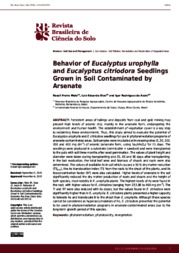Behavior of Eucalyptus urophylla and Eucalyptus citriodora seedlings grown in soil contaminated by arsenate.
Behavior of Eucalyptus urophylla and Eucalyptus citriodora seedlings grown in soil contaminated by arsenate.
Author(s): MELO, R. F. de; DIAS, L. E.; ASSIS, I. R. de
Summary: Persistent areas of tailings and deposits from coal and gold mining may present high levels of arsenic (As), mainly in the arsenate form, endangering the environment and human health. The establishment of vegetation cover is a key step to reclaiming these environments. Thus, this study aimed to evaluate the potential of Eucalyptus urophylla and E. citriodora seedlings for use in phytoremediation programs of arsenate-contaminated areas. Soil samples were incubated at increasing rates (0, 50, 100, 200 and 400 mg dm-3) of arsenic (arsenate form, using Na 2HAsO4) for 15 days. The seedlings were produced in a substrate (vermiculite + sawdust) and were transplanted to the pots with soil three months after seed germination. The values of plant height and diameter were taken during transplanting and 30, 60 and 90 days after transplanting. In the last aluation, the total leaf area and biomass of shoots and roots were also determined. The values of available As in soil which caused a 50 % dry matter reduction TS50%), the As translocation index (TI) from the roots to the shoot of the plants, and its bioconcentration factor (BF) were also calculated. Higher levels of arsenate in the soil significantly reduced the dry matter production of roots and shoots and the height of both species, most notably in E. urophylla plants. The highest levels of As were found in the root, with higher values for E. citriodora (ranging from 253.86 to 400 mg dm-3). The TI and BF were also reduced with As doses, but the values found in E. citriodora were significantly higher than in E. urophylla. E. citriodora plants presented a higher capacity to tolerate As and translocate it to the shoot than E. urophylla . Although these species cannot be considered as hyperaccumulators of As, E. citriodora presented the potential to be used in phytoremediation programs in arsenate-contaminated areas due to the long-term growth period of this species.
Publication year: 2016
Types of publication: Journal article
Unit: Embrapa Semi-arid Region
Observation
Some of Embrapa's publications are published as ePub files. To read them, use or download one of the following free software options to your computer or mobile device. Android: Google Play Books; IOS: iBooks; Windows and Linux: Calibre.
Access other publications
Access the Agricultural Research Database (BDPA) to consult Embrapa's full library collection and records.
Visit Embrapa Bookstore to purchase books and other publications sold by Embrapa.

